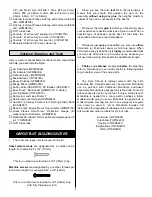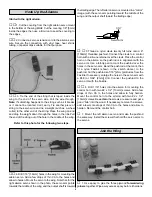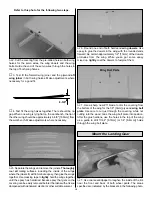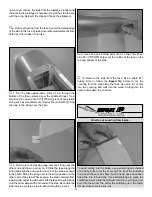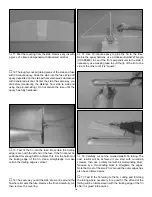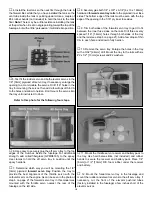
not enough, remove the stab from the fuselage. Lightly sand
the slots in the fuselage as necessary to get the stab to align
with the wing. Reinsert the stab and check the alignment.
❏
6. Remove the wing from the fuse. Center the trailing edge
of the stab in the fuse by taking accurate measurements from
both tips to the sides of the fuse.
❏
7. Turn the fuse upside-down. Stick a T-pin through the
bottom of the fuse centered over the middle stringer. Tie a
small loop in one end of a 50" [1270mm] piece of non-elastic
string such as monofilament or Kevlar line (K+SR4575). Slip
the loop in the string over the T-pin.
❏
8. Fold a piece of masking tape over the string near the
other end and draw an arrow on it. Slide the tape along the
string and align the arrow with one end of the stab as shown
in the photo. Swing the string over to the same position on the
other end of the stab. While keeping the stab centered from
side-to-side, adjust the stab and slide the tape along the string
until the arrow aligns with both ends of the stab. Be certain the
stab remains centered, side-to-side, during this process.
❏
9. Use a fine-point felt-tip pen such as a Top Flite
®
Panel
Line Pen (TOPQ2510) to mark the outline of the fuse on the
top and bottom of the stab.
❏
10. Remove the stab from the fuse. Use a sharp #11
hobby knife or follow the Expert Tip below to cut the
covering from the stab along the lines. Use care to cut only
into the covering and not into the wood. Cutting into the
balsa will weaken the structure.
How to cut covering from balsa.
To avoid cutting into the balsa, use a soldering iron instead
of a hobby knife to cut the covering. The tip of the soldering
iron doesn't have to be sharp, but a fine tip does work best.
Allow the iron to heat fully. Use a straightedge to guide the
soldering iron at a rate that will just melt the covering and not
burn into the wood. The hotter the soldering iron, the faster
it must move to melt a fine cut.
13





